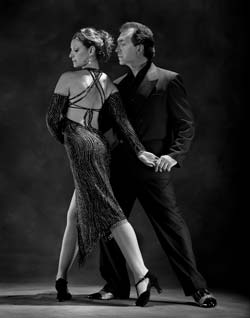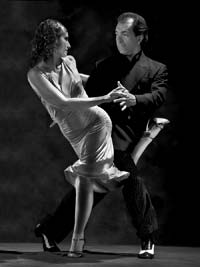By
Naveira - Virtual chat with Gustavo and Giselle

here are two kinds of tango fans that express their passion in a very different way: those who listen and those who dance. Among the first ones the collectors, the broadcasters and the researchers stand out; that is my case. Among the others, the milongueros, the dancers and the instructors; the case of the guys I interview now. Talking with Gustavo and his dancing partner Giselle turns out into a learning experience for anyone and, especially for the one who writes this. It was like entering an alien world that I hardly know because of my scarce forays into milongas and festivals. This virtual conversation encompassed several e-mails we have interchanged for over a week.
«I was born on August 12, 1960 in the Patagonian region, in Comodoro Rivadavia (province of Chubut). My parents had moved there to run a shop but all my family was from Buenos Aires. When I was one year old we came back to the capital city.
«When I was a child I was nurtured with tango, at home we used to listen to tango and my parents met when they were dancing tango. As you can see, tango was in my life before my birth. But my first steps with dancing occurred unexpectedly when I studied economy in the University of Buenos Aires where there was a course which I attended. There I came to know of my affinity with dancing. Later I studied folk music dancing and enrolled in short courses of classical, modern and Spanish dances. But always it was rather out of curiosity than for a professional interest.
«But after I started with tango everything was tango and I owe everything to it, including my love for Giselle, my wife and my dancing partner. Furthermore, all my children are the result of my relationship with a dancer.
«The first teacher I had was Rodolfo Dinzel. But I learnt things from several milongueros in a not much organized way. An instructor that gave me a lot was Pepito Avellaneda but I cannot leave unmentioned Antonio Todaro and Gerardo Portalea.
«When they ask me what is that I enjoy most, dancing or teaching, I answer: both things. In my early years, already a professional, I very much liked dancing onstage, the audience generated for me energy and pleasure at the same time. But my work as educator caught me strongly and today I enjoy my classes very much and also the task of researching and analyzing all the possibilities that tango has as a dance. I am sure that there is still too much to do and discover.
 «Dancing is something that constantly evolves and this is something inevitable which you cannot restrain. However, the tango we like to dance to is the traditional one, the one that prevails in the milongas (dancehalls), the tango of the 40s. But today it is not danced as then, the context is different, life has changed, but despite it is updated is a genuine evolution respectful for essences.
«Dancing is something that constantly evolves and this is something inevitable which you cannot restrain. However, the tango we like to dance to is the traditional one, the one that prevails in the milongas (dancehalls), the tango of the 40s. But today it is not danced as then, the context is different, life has changed, but despite it is updated is a genuine evolution respectful for essences.
«When it is said “new tango” it means the fact of doing things with technical innovations. They are different images of a process which, in fact, represents the evolution we are talking of. A process which does not stop and that has been coming since many years. Dancing itself is the beneficiary because it gets a great number of new tools which not only we enjoy but also ponder very much.
«Dancing uninterruptedly for more than thirty years allowed me to know and understand the rabbit trails of the technical structure upon which tango is organized. They were not just a day or two, nor was I the only one. It meant a long time and many the dancers that were following this process of evolution in which we discovered new possibilities in dancing.
«Something that tango always lacked is an intellectual analysis of how it works, how it is built and how we take part in that process with great intensity; now we have a fairly wide knowledge of how it is. Precisely, I am associated with this change but, I repeat, I was not the only one, other dancers also greatly contributed to this process and brought very good things.
«I find much pleasure in teaching and I do it happily. Recently in a chronicle by Martín Nussbaum —I think it was exaggerated—, referred to the classes we have just given in New York in May 2013, under the sparkling heading: “Why Gustavo Naveira is the best Tango teacher alive?”, among other things he mentions that happiness and humor are perceived in my classes. I admit that it is true because it is the way I found so that my students would get confidence and express themselves naturally, without pressure, in the hard work of learning.
 «As for our performances and career it turns out tedious going backwards, I can only say that we never stop. Since 2010 we have been presenting an Annual Festival in Boulder, Colorado, the city where we live now. In 2013 it is scheduled for the first weekend of October and it will feature Chicho Frumboli and Juana Sepúlveda and two of my children, Ariadna Naveira and Fernando Sánchez, Federico Naveira and Sabrina Masso.
«As for our performances and career it turns out tedious going backwards, I can only say that we never stop. Since 2010 we have been presenting an Annual Festival in Boulder, Colorado, the city where we live now. In 2013 it is scheduled for the first weekend of October and it will feature Chicho Frumboli and Juana Sepúlveda and two of my children, Ariadna Naveira and Fernando Sánchez, Federico Naveira and Sabrina Masso.
«Besides this show, we go on giving seminars in Argentina, twice a year (usually in July and December). They are held at the La Papelera, a venue in the neighborhood of San Telmo which we are trying to promote and fill with tango activity to make it our center in Buenos Aires. Furthermore, we continue with our workshops in the United States which we began four years ago. We have a fixed appointment in New York in the week of the Thanksgiving Day (last week of November). In 2013 we add a visit in May with workshops and exhibition.
«The latest news is the opening of our own studio in the United States: the Boulder Tango Studio and its opening is scheduled for the late September 2013. At this venue we shall display a more detailed program for scholars of tango-dance.
«If you ask me about a special memory I have to go back to 1994, precisely to the first festival in Sitges, Catalonia because at that beautiful Mediterranean city I met Giselle».

As a finale, here’s Giselle’s contribution: «I am the first admirer of Gustavo’s, an exquisite dancer and a great teacher. His teaching method is of excellence and is based on the dynamics of the couple, on the intense relationship between man and woman so that the dance becomes an organic question in which leading and following are more important than the way of the movement».